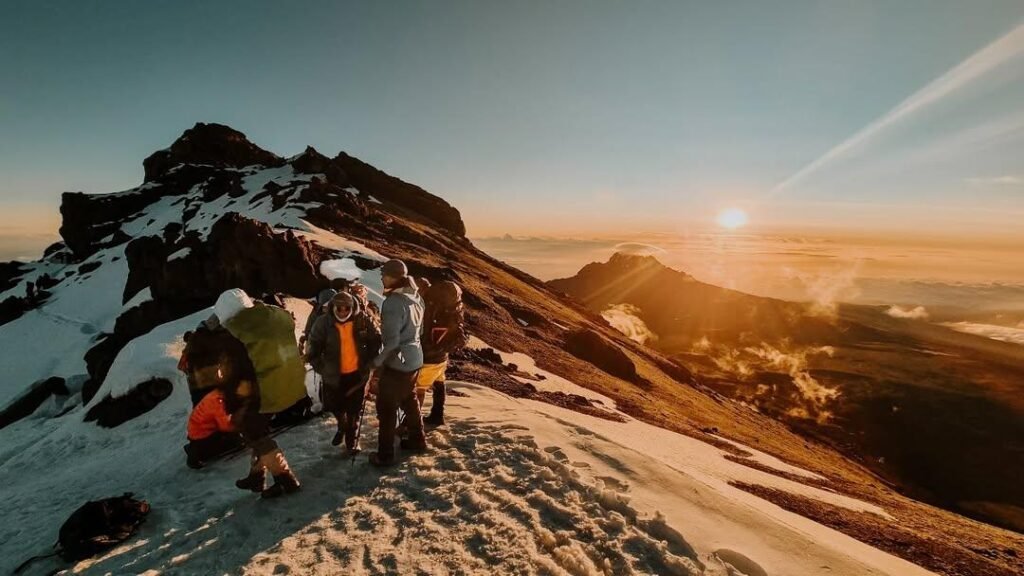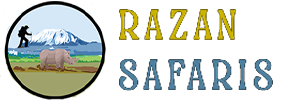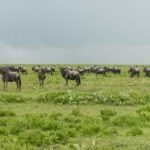The Most Difficult Route to Climb Mount Kilimanjaro: The Umbwe Route is widely regarded as the most challenging route to the summit of Mount Kilimanjaro.
The Most Difficult Route to Climb Mount Kilimanjaro : Overview
Length: Approximately 50 kilometers (31 miles)
Duration: Typically 5 to 7 days
Starting Altitude: 1,600 meters (5,249 feet) at Umbwe Gate
Summit Altitude: 5,895 meters (19,341 feet) at Uhuru Peak
Climbing Profile: Steep, direct, and rapid ascent with limited acclimatization opportunities
Key Challenges

The Most Difficult Route to Climb Mount Kilimanjaro : Steep Initial Ascent:
The Umbwe Route starts with an extremely steep ascent through dense rainforest. This rapid gain in altitude can be physically demanding and leaves little time for acclimatization.
Impact: Climbers often experience early symptoms of altitude sickness due to the swift altitude gain.
The Most Difficult Route to Climb Mount Kilimanjaro : Limited Acclimatization:
The route’s design involves a fast and direct climb, which does not allow for gradual acclimatization.
Impact: The lack of gradual altitude gain increases the risk of altitude sickness, making it challenging for climbers to adapt to the lower oxygen levels.
The Most Difficult Route to Climb Mount Kilimanjaro : Challenging Terrain:
The Umbwe Route features rugged and rocky paths, especially after the rainforest zone. The trail requires careful navigation through exposed ridges and steep sections.
Impact: The difficult terrain demands high physical fitness and strong mental resilience. Climbers need to be prepared for strenuous hiking and potentially scrambling.
The Most Difficult Route to Climb Mount Kilimanjaro : Harsh Weather Conditions:
As climbers ascend quickly, they encounter a variety of weather conditions, from humid rainforests to cold alpine deserts.
Impact: The rapid transition through different climatic zones can be tough to manage without adequate gear and preparation.
The Most Difficult Route to Climb Mount Kilimanjaro : Summit Night:
Like other routes, the final push to the summit starts around midnight, making the ascent in darkness and cold temperatures.
Impact: The combination of physical exhaustion, high altitude, and challenging conditions make the summit night particularly grueling on the Umbwe Route.









Thanks for sharing. I read many of your blog posts, cool, your blog is very good.
Your point of view caught my eye and was very interesting. Thanks. I have a question for you.
I am sure this piece of wriging has touched all the internet
users, its really reakly good paragraph on buiilding up
new weblog. https://hallofgodsinglassi.wordpress.com/
Your article helped me a lot, is there any more related content? Thanks!
dianabol sustanon cycle
References:
Valley.md
Thank you for your sharing. I am worried that I lack creative ideas. It is your article that makes me full of hope. Thank you. But, I have a question, can you help me?
I don’t think the title of your article matches the content lol. Just kidding, mainly because I had some doubts after reading the article.
Thank you for your sharing. I am worried that I lack creative ideas. It is your article that makes me full of hope. Thank you. But, I have a question, can you help me? https://www.binance.info/it/join?ref=S5H7X3LP
I don’t think the title of your article matches the content lol. Just kidding, mainly because I had some doubts after reading the article.
Thank you for your sharing. I am worried that I lack creative ideas. It is your article that makes me full of hope. Thank you. But, I have a question, can you help me?
What’s right for a man considerably varies from what fits a girl, largely because of
their lower tolerance for these compounds and the
goal to avoid unwanted unwanted effects like virilization. All the same knowledge utilized by professional BB’rs to forge their
physiques into the show-stopping specimens we see within the magazines is out there to all of us.
There are not any designer medication responsible for catapulting the professionals into the higher echelon of the game, nor are there any secret drug combos
known only by a chosen few.
This is key for muscle healing and progress after tough exercises.
The higher rate of protein creation is a main advantage of steroids,
serving to muscular tissues develop quicker. Well-being, sexual well being, and outcomes
are inclined to endure post-cycle; nevertheless, an efficient PCT helps to reverse these opposed effects.
Our patients will usually run a PCT post-Anadrol cycle to
speed up the restoration of endogenous testosterone production. This cycle incorporates cautious doses of Anadrol, despite research indicating higher doses may presumably be taken with none further risk of virilization.
There’s a restricted selection of steroids obtainable for female cutting cycles.
Anavar may also be used for chopping by altering caloric consumption and training type.
To limit the chance of side effects, Anavar is used during
the preliminary 4 weeks, at a dosage of 10-20mg per day.
Steroid stacks mix two or more compounds so you probably can mix their benefits and obtain greater outcomes than using
just one compound alone. Newbie stacks can be easy, whereas superior users
can easily mix three or more compounds in a cycle. Another combo of legendary compounds provides Deca instead of Tren.
Adequate NO production is important for the supply of blood to penile tissue.
This is indicative of its use by a seasoned steroid person,
with Anadrol being a poisonous steroid. It is challenging to judge the efficacy of Deca Durabolin in isolation, as it’s often combined with different
anabolic steroids. Despite this, we’ve observed reduced anabolism in users who take away Deca Durabolin from stacks.
Trenbolone may also suppress endogenous testosterone levels, resulting in male
hypogonadism.
For instance, a stack that consists of Winstrol,
Anadrol, Trenbolone, or Superdrol is for superior
steroid customers. This can lead to a depletion of your sperm quality and quantity.
A PCT is crucial and it shouldn’t be skipped in any other case your natural testosterone ranges will not get well easily.
Take Tren at 300mg weekly, Anavar at 50mg day by
day, and don’t overlook your testosterone prop at
300mg weekly. It is perfect for contest prep, particularly if you add Halotestin for the last three weeks
of the cycle, which will harden up the physique whereas boosting power fairly dramatically.
As A Result Of of the quick length of these cycles, usually now not than 4 to 6 weeks, only short-acting or fast-acting steroids
are used. These compounds start working rapidly, thus
making it possible to attain fast gains. This appears like a quite simple cycle at first look, as you’re going back to basics with only
a single testosterone compound.
However as I’ll detail later, the selection between which of the following are functions of steroids? select all that apply. kind to take comes down to extra than just your choice for swallowing a pill or
injecting. I would use 0.5mg/day of Arimidex day by day while working Deca or 10mg/day of Aromasin. After your final deca shot,
wait two full weeks earlier than utilizing Clomid. Nandrolone is immensely well-liked,
and you can see this to be a straightforward steroid to
find and buy in most components of the world. Deca-Durabolin is mostly more in style and extra generally
found than NPP, however it’s unlikely you’ll run into difficulty in shopping for both form of Nandrolone.
With much less muscle and joint pain to deal with during and after workouts, plus elevated bone power, you will
find it easier to increase your maximum weight and recover
sooner. Not Directly, this results in faster positive aspects and the ability to have much less of a break for restoration between every exercise.
Don’t be fooled by how fundamental this cycle looks as a
end result of it really works. Winny will give you the
dry, onerous look you want with this stack.
All three compounds mix to ship a hard and ripped physique,
and they can do that at pretty free doses thanks to the unbelievable way they all work
together. A stack of two of probably the most legendary
cutting steroids can’t allow you to down. Anavar
is a nice mild steroid and, at reasonable doses, is side-effect-friendly.
With its highly effective natural method, real customer outcomes, and a 60-day money-back guarantee, D-Bal proves you don’t want unlawful steroids to rework
your physique. For health enthusiasts looking for real, measurable progress—without playing on their health—Crazy Bulk represents a new period of pure efficiency supplementation. By Way Of its lineup of
carefully formulated authorized steroid alternate options, Crazy Bulk delivers targeted help
for muscle growth, power, and fats loss whereas staying away from banned substances
or prescription-only options.
This stack considerably raises the risk of creating gynecomastia, as both
steroids are estrogenic. Consequently, it’s crucial to make the most of a selective estrogen receptor modulator (SERM) similar to Nolvadex during the cycle.
Dr. Ziegler subsequently created methandrostenolone, extra
broadly known as Dianabol. Dianabol had an anabolic score that was
higher than that of testosterone, and its androgenic effects have been less pronounced.
We frequently observe Deca Durabolin eliciting impotence throughout a cycle, which might have an unlucky impact
on the sexual health of male customers. This is the outcomes of Deca Durabolin’s significantly increasing prolactin ranges.
We prescribe cabergoline to patients to deal with this imbalance, inhibiting the production of prolactin and sustaining
libido.
The time frames vary, but lots of the products are described as producing noticeable results within weeks.
For example, customers of Crazy Bulk Bulking
Stack reportedly feel effects inside days. Yes, merchandise like D-Bal
Max are talked about to aid in fats loss and enhance muscle definition while helping to construct muscle.
In the case of Deca-Durabolin, this is generally thought-about a reasonable risk.
The resumption of pure testosterone production can take many months if left
to occur by itself. A PCT cycle is essential following using Deca-Durabolin in order
that testosterone manufacturing may be inspired to start occurring sooner and quicker and that can assist
you avoid a state of low testosterone. Deca is notorious for inflicting sexual issues
in some men and is usually the primary reason males will hesitate to use it, but not all males will expertise this in any respect.
One method to keep away from this issue is to stack Deca with another
steroid that can promote nitric oxide ranges, like Trenbolone or larger doses of testosterone.
Many guys who discuss impressive energy gains with Deca-Durabolin are stacking it with
a minimum of testosterone, and often over 600mg per
week of testosterone. Testosterone will significantly boost your
strength, so that stacked mixture will take your energy to a different level,
much more so than utilizing Deca-Durabolin alone. Its therapeutic results are
as necessary, although not bodily apparent, as your dimension features or body recomposition. Performance athletes may even benefit from strengthening and therapeutic joint
and connective tissue. Women using Deca-Durabolin for long periods are at larger risk of
growing indicators of masculinization, like a deep voice and
body hair progress. Girls who wish to avoid these signs
cycles should be stored to six weeks with a adequate break in between.
Nonetheless, customers ought to be snug working trenbolone-only cycles first earlier than serious
about stacking it with other compounds because of its high cardiotoxicity.
Testosterone is especially androgenic; subsequently, zits
vulgaris and hair loss or recession can occur in bodybuilders susceptible to such unwanted aspect effects.
The nickname “A-Bombs” for Anadrol is fitting, as its physiological results resemble dropping a
bomb on the liver. We have seen extensive cycles and
high doses cause excessive quantities of hepatic harm and, in some instances, cause cirrhosis.
Most people know that mindlessly repeating workout routines at the health club just isn’t enough.
You want one thing extra if you need to push your self more
durable and obtain peak physical form. Individuals used to resort
to abusing steroids and different crazy and banned
medicine earlier. These gave folks massively ripped our bodies, however that they had huge side effects too.In 2006, the group behind
Loopy Bulk entered the fitness dietary supplements market.
The staff at Crazy Bulk can also be greatly into bodily health and hitting the fitness center onerous.
These folks actually understand the want to keep protected and authorized whereas figuring out.
If not, extra recovery time — or physician-guided treatment — could
also be essential. As Soon As your testosterone base is in place, the following
step is choosing which compounds to pair based mostly on your objective.
This is where stacking gets strategic — totally different combinations have an result on water retention, androgenic load, restoration, and
aesthetics in very alternative ways. Biking is a good possibility when you
need to schedule your peaking level beyond 2 months out. If you wish
to put on slabs of muscle mass, but in addition fine tune these abs and biceps cuts with large veins, than cycling is
finest for you. Prime manufacturers like CrazyBulk focus closely
on clean, clear formulas that support pure muscle
building and total male efficiency enhancement.
References:
legit research chemical Supplies sites Bodybuilding
I don’t think the title of your article matches the content lol. Just kidding, mainly because I had some doubts after reading the article.
Can you be more specific about the content of your article? After reading it, I still have some doubts. Hope you can help me.
Can you be more specific about the content of your article? After reading it, I still have some doubts. Hope you can help me.
Buy Account Database of Accounts for Sale
Sell Account Purchase Ready-Made Accounts
Secure Account Sales Account Buying Service
Database of Accounts for Sale Account Purchase
Account Selling Platform Account marketplace
Social media account marketplace Account trading platform
Verified Accounts for Sale Sell accounts
Social media account marketplace Guaranteed Accounts
Account Acquisition Account Market
Account marketplace Ready-Made Accounts for Sale
аккаунты с балансом профиль с подписчиками
магазин аккаунтов социальных сетей купить аккаунт
продажа аккаунтов соцсетей маркетплейс аккаунтов
продать аккаунт маркетплейс аккаунтов соцсетей
магазин аккаунтов https://magazin-akkauntov-online.ru/
продать аккаунт профиль с подписчиками
заработок на аккаунтах гарантия при продаже аккаунтов
Thank you for your sharing. I am worried that I lack creative ideas. It is your article that makes me full of hope. Thank you. But, I have a question, can you help me?
I don’t think the title of your article matches the content lol. Just kidding, mainly because I had some doubts after reading the article.
Rely on BWER Company for superior weighbridge solutions in Iraq, offering advanced designs, unmatched precision, and tailored services for diverse industrial applications.